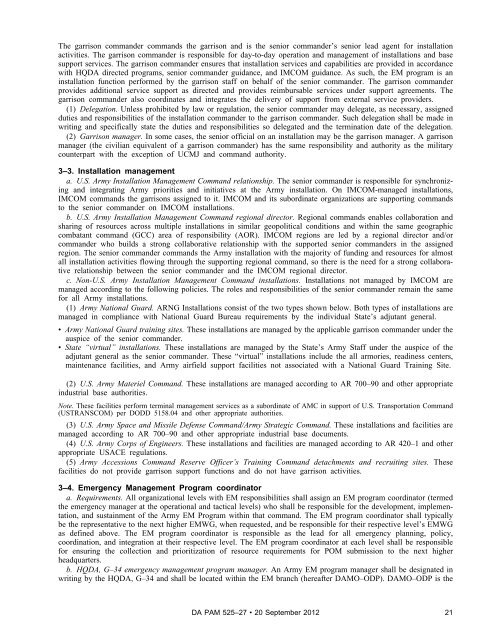Army Emergency Management Program - Federation of American ...
Army Emergency Management Program - Federation of American ...
Army Emergency Management Program - Federation of American ...
You also want an ePaper? Increase the reach of your titles
YUMPU automatically turns print PDFs into web optimized ePapers that Google loves.
The garrison commander commands the garrison and is the senior commander’s senior lead agent for installation<br />
activities. The garrison commander is responsible for day-to-day operation and management <strong>of</strong> installations and base<br />
support services. The garrison commander ensures that installation services and capabilities are provided in accordance<br />
with HQDA directed programs, senior commander guidance, and IMCOM guidance. As such, the EM program is an<br />
installation function performed by the garrison staff on behalf <strong>of</strong> the senior commander. The garrison commander<br />
provides additional service support as directed and provides reimbursable services under support agreements. The<br />
garrison commander also coordinates and integrates the delivery <strong>of</strong> support from external service providers.<br />
(1) Delegation. Unless prohibited by law or regulation, the senior commander may delegate, as necessary, assigned<br />
duties and responsibilities <strong>of</strong> the installation commander to the garrison commander. Such delegation shall be made in<br />
writing and specifically state the duties and responsibilities so delegated and the termination date <strong>of</strong> the delegation.<br />
(2) Garrison manager. In some cases, the senior <strong>of</strong>ficial on an installation may be the garrison manager. A garrison<br />
manager (the civilian equivalent <strong>of</strong> a garrison commander) has the same responsibility and authority as the military<br />
counterpart with the exception <strong>of</strong> UCMJ and command authority.<br />
3–3. Installation management<br />
a. U.S. <strong>Army</strong> Installation <strong>Management</strong> Command relationship. The senior commander is responsible for synchronizing<br />
and integrating <strong>Army</strong> priorities and initiatives at the <strong>Army</strong> installation. On IMCOM-managed installations,<br />
IMCOM commands the garrisons assigned to it. IMCOM and its subordinate organizations are supporting commands<br />
to the senior commander on IMCOM installations.<br />
b. U.S. <strong>Army</strong> Installation <strong>Management</strong> Command regional director. Regional commands enables collaboration and<br />
sharing <strong>of</strong> resources across multiple installations in similar geopolitical conditions and within the same geographic<br />
combatant command (GCC) area <strong>of</strong> responsibility (AOR). IMCOM regions are led by a regional director and/or<br />
commander who builds a strong collaborative relationship with the supported senior commanders in the assigned<br />
region. The senior commander commands the <strong>Army</strong> installation with the majority <strong>of</strong> funding and resources for almost<br />
all installation activities flowing through the supporting regional command, so there is the need for a strong collaborative<br />
relationship between the senior commander and the IMCOM regional director.<br />
c. Non-U.S. <strong>Army</strong> Installation <strong>Management</strong> Command installations. Installations not managed by IMCOM are<br />
managed according to the following policies. The roles and responsibilities <strong>of</strong> the senior commander remain the same<br />
for all <strong>Army</strong> installations.<br />
(1) <strong>Army</strong> National Guard. ARNG Installations consist <strong>of</strong> the two types shown below. Both types <strong>of</strong> installations are<br />
managed in compliance with National Guard Bureau requirements by the individual State’s adjutant general.<br />
<strong>Army</strong> National Guard training sites. These installations are managed by the applicable garrison commander under the<br />
auspice <strong>of</strong> the senior commander.<br />
State “virtual” installations. These installations are managed by the State’s <strong>Army</strong> Staff under the auspice <strong>of</strong> the<br />
adjutant general as the senior commander. These “virtual” installations include the all armories, readiness centers,<br />
maintenance facilities, and <strong>Army</strong> airfield support facilities not associated with a National Guard Training Site.<br />
(2) U.S. <strong>Army</strong> Materiel Command. These installations are managed according to AR 700–90 and other appropriate<br />
industrial base authorities.<br />
Note. These facilities perform terminal management services as a subordinate <strong>of</strong> AMC in support <strong>of</strong> U.S. Transportation Command<br />
(USTRANSCOM) per DODD 5158.04 and other appropriate authorities.<br />
(3) U.S. <strong>Army</strong> Space and Missile Defense Command/<strong>Army</strong> Strategic Command. These installations and facilities are<br />
managed according to AR 700–90 and other appropriate industrial base documents.<br />
(4) U.S. <strong>Army</strong> Corps <strong>of</strong> Engineers. These installations and facilities are managed according to AR 420–1 and other<br />
appropriate USACE regulations.<br />
(5) <strong>Army</strong> Accessions Command Reserve Officer’s Training Command detachments and recruiting sites. These<br />
facilities do not provide garrison support functions and do not have garrison activities.<br />
3–4. <strong>Emergency</strong> <strong>Management</strong> <strong>Program</strong> coordinator<br />
a. Requirements. All organizational levels with EM responsibilities shall assign an EM program coordinator (termed<br />
the emergency manager at the operational and tactical levels) who shall be responsible for the development, implementation,<br />
and sustainment <strong>of</strong> the <strong>Army</strong> EM <strong>Program</strong> within that command. The EM program coordinator shall typically<br />
be the representative to the next higher EMWG, when requested, and be responsible for their respective level’s EMWG<br />
as defined above. The EM program coordinator is responsible as the lead for all emergency planning, policy,<br />
coordination, and integration at their respective level. The EM program coordinator at each level shall be responsible<br />
for ensuring the collection and prioritization <strong>of</strong> resource requirements for POM submission to the next higher<br />
headquarters.<br />
b. HQDA, G–34 emergency management program manager. An <strong>Army</strong> EM program manager shall be designated in<br />
writing by the HQDA, G–34 and shall be located within the EM branch (hereafter DAMO–ODP). DAMO–ODP is the<br />
DA PAM 525–27 20 September 2012<br />
21
















